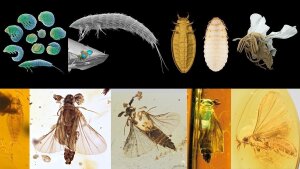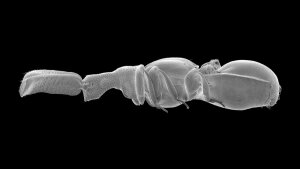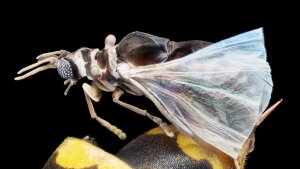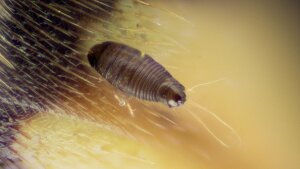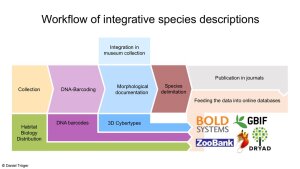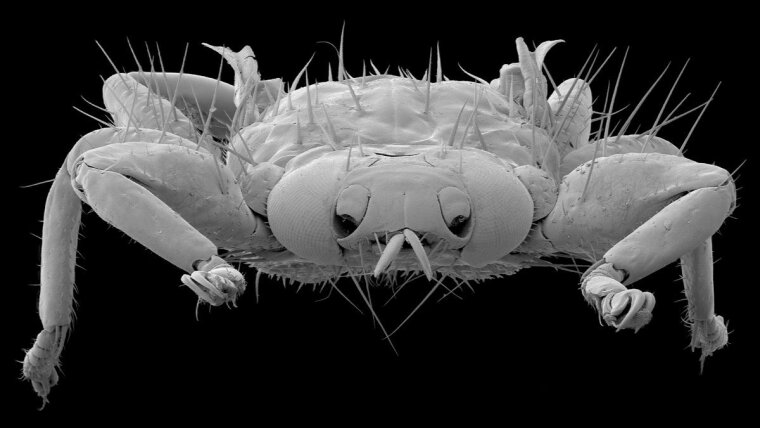
Life stages of various Strepsiptera. Top row from left to right: embryos, primary larva, last larval stage, free-living female, male. Bottom row: stem group representatives.
Image: Hans PohlPhylogeny and evolution of twisted-winged parasites (Strepsiptera)
This project deals with the morphology and evolution of Strepsiptera, especially the neoteny of the females. In addition, we also work on miniaturisation effects, mainly on the stemmata of primary larvae, the postembryonic development of selected taxa, and stem group representatives of the order.
People involved: PD Dr. Hans Pohl, Prof. Dr. Rolf G. Beutel, Daniel Tröger, Michael Weingardt
Cooperation partners: Dr. Stefan Fischer (University of Tübingen), Dr. Jörg U. Hammel (DESY Hamburg), Dr. Thomas van de Kamp (KIT Karlsruhe)
Tiraspirus tabulatus, scanning electron micrograph.
Image: Paweł JałoszyńskiPhylogeny and evolution of Pselaphinae and other extant and extinct groups of staphylinoid beetles
The primary objective of this project is the documentation of the hitherto almost completely unknown anatomy of the structurally and biologically megadiverse Pselaphinae. Patterns of highly diverse and multiple structural transformations will be analysed. A DFG project planned under the leadership of Dr. Margarita I. Yavorskaya (University of Tübingen) will also include phylogenetic analyses based on molecular data and analyses of the genetic background of the morphological megadiversity.
People involved: Prof. Dr. Rolf G. Beutel, Xiaozhu Luo
Cooperation partners: Dr. Paweł Jałoszyński (Museum of Natural History, University of Wrocław, Poland), Dr. Margarita I. Yavorskaya (University of Tübingen)
In copula fixed Xenos vesparum.
Image: Hans PohlReproductive and mating strategies of Strepsiptera
This project will shed new light on the reproductive biology of Strepsiptera by applying an interdisciplinary approach. This includes a wide array of modern research methods, ranging from comparative anatomy and functional morphology to molecular biology and biomechanics.
People involved: PD Dr. Hans Pohl, Prof. Dr. Oliver Niehuis (University of Freiburg), Prof. Dr. Rolf G. Beutel
Cooperation partners: Prof. Dr. Stanislav N. Gorb (Kiel University), Dr. Jakub Straka (Charles University, Prague, Czech Republic), Dr. Thomas van de Kamp (KIT Karlsruhe)
Funding: DFG, German Research Foundation
Primary larva of Xenos vesparum on its host Polistes dominula.
Image: Hans PohlPhysical interactions of adhesive devices of Strepsiptera with different surfaces
The following topics are dealt with in this project: The ultrastructure of adhesive hairs on the tarsi of strepsipteran males; the forces which are involved in attaching to differ surfaces; the ultrastructure of the tarsal adhesive pads of the primary larvae and attachment forces applied during attachment on the host.
People involved: PD Dr. Hans Pohl
Cooperation partner: Prof. Dr. Stanislav N. Gorb (Kiel University)
Workflow of integrative species descriptions.
Graphic: Daniel TrögerDevelopment of a workflow for modern integrative species descriptions of insects
The aim of this project is to develop a standardised and easily reproducible workflow for a rapid and detailed description of new insect species. To achieve this goal, integrative taxonomy, modern non-invasive methods and cybertaxonomy will be combined.
People involved: Daniel Tröger, PD Dr. Hans Pohl
Cooperation partner: Dr. Thomas van de Kamp (KIT Karlsruhe)
Funding: DBU, German Federal Environmental Foundation
This is linked to the PhD project of Daniel Tröger (see above). The developed workflow will be applied to presently undescribed species of Strepsiptera from different world regions. The material is mostly in the research collection of PD Dr. Hans Pohl.
People involved: Daniel Tröger, PD Dr. Hans Pohl
Cooperation partners: Daniel Benda, Dr. Jakub Straka (Charles University, Prague, Czech Republic)
Funding: DBU, German Federal Environmental Foundation
